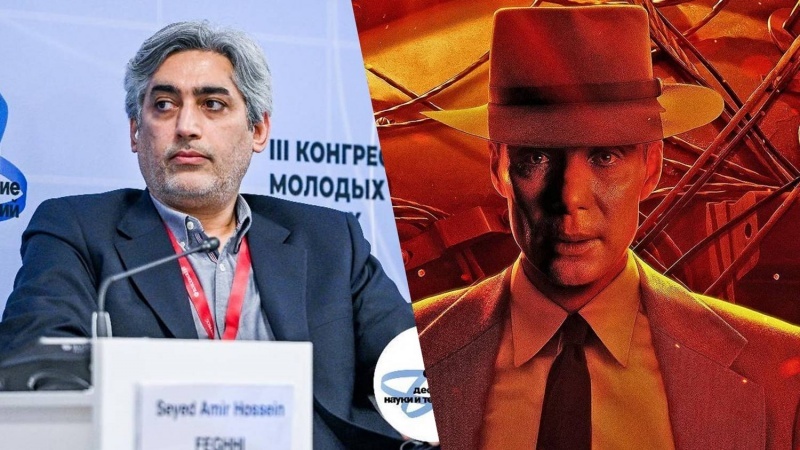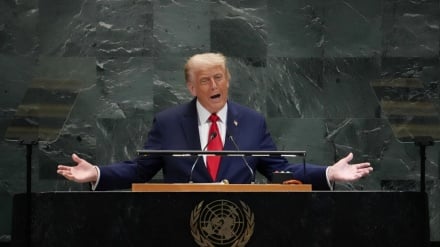The West's double standard in hero-making and assassination; Oppenheimer
Pars Today – In 2023, Christopher Nolan’s biographical film Oppenheimer earned nearly one billion dollars at the box office, portraying the "father of the atomic bomb" as a complex, tragic, and heroic figure. In 2025, Israel—continuing the pattern of its actions in previous years—assassinated and martyred a number of Iranian nuclear scientists who were engaged in non-military research and development.
In 2023, Nolan’s Oppenheimer depicted a patriotic man who raced the Nazis in order to save the world, yet whose creation ultimately dragged both himself and the world into a state of terror and ushered in a new era.
According to Pars Today, citing Ham-Mihan newspaper: In the real world, decades later, Iranian soil has been blatantly violated, and its nuclear scientists are being targeted and assassinated by the Zionist regime in blind acts of terror.
A great discovery to save the world
The heroic portrayal of J. Robert Oppenheimer is inseparable from the historical and moral context in which his work was carried out—namely, World War II. In Western consciousness, WWII was more than just a war; it was a fundamental moral event against the undeniable evil of fascism, understood as a “just war.”
This perception provided a rational and moral justification for the Manhattan Project. In fact, the Manhattan Project was narrated as a race against time. The main fear, as Albert Einstein stated in his 1939 letter to President Roosevelt, was that the Germans—with leading scientists like Werner Heisenberg—might succeed in building an atomic bomb before the Allies.
If you’ve seen the film Oppenheimer, you know that after the success of building the atomic bomb, Oppenheimer suffered from guilt and was tormented by being labeled “the destroyer of worlds.” In the Western narrative—and even in Nolan’s film—there is no hesitation in portraying the horrific consequences of building the bomb and the moral dilemmas of its creator. Yet, Oppenheimer, despite his inner conflicts and implicit remorse, is never turned into a villain. On the contrary, he is seen as a tragic hero who, with his extraordinary intellect, ambition, and model patriotism, responded correctly to a historic global challenge.
Here, success is so deeply highlighted and understood through the lens of its time that the burden of living with the horrific outcome of one’s achievement is rendered irrelevant, and perhaps even viewed with sympathy. This is a very precise narrative shift—so much so that, in his 1954 security clearance hearing, Oppenheimer was praised not for what he regretted, but because he was a brilliant man who did what his country asked of him during a time of crisis—and whether he now struggles with its moral consequences is deemed unimportant.
Security is built within words
It is enough for someone to turn a subject into an existential threat through the power of language—once that happens, the path is opened for any action, whether it be sanctions, military strikes, assassinations, or even territorial fragmentation. This framework shows how a subject that is inherently technical can be transformed into an existential threat.
A matter takes on the form of a security threat when an actor—whose role and expertise lie in securitization—uses rhetorical power to convince the audience that a profound danger threatens the current valuable order and existence.
As a result, through this very narrative, actions that lie outside international political norms and conventions are portrayed as logical—even necessary.
On Iran’s nuclear program, the main securitizing agents are the United States and Israel. For decades, the central task of their political leaders and security officials has been active participation in this very "speech act". They have relentlessly framed Iran’s nuclear program not as a technical issue governed by the rules and regulations of the International Atomic Energy Agency (IAEA) and Iran’s inherent rights, but rather as a Damoclean sword hanging over Israel and the global order.
The U.S. and Israel constructed this narrative through continuous othering: Iran was cast as an irrational, isolated, and untrustworthy state—a country for which conventional deterrence does not work, because its logic and rationality are fundamentally different from others’.
In this narrative, discursive construction is critical, because it is based on the assumption that deterrence—which serves as an effective strategic tool in nuclear policy for many states—becomes, in Iran’s case, an apocalyptic threat.
Whereas Oppenheimer worked within the framework of a declared world war against a state enemy, Iranian scientists operate under a murkier cloud of secrecy and global suspicion.
The foundational element of this Israeli-Western narrative is drawing a direct link between Iran’s nuclear scientists and the Islamic Republic itself as a "rogue state," thereby creating a justification for their physical elimination.
Frameworks that create heroes and victims
When these two narratives are compared within a media framework, the differences become even more apparent. The story of Oppenheimer and that of Iranian nuclear scientists represent a classic case of media framing—where the media do not merely report news, but through selective emphasis and highlighting certain aspects of reality, construct a particular narrative.
Framing theory holds that every story can be broken down into key elements: the definition of the problem, its cause, the moral judgment, and the proposed solution. In the case at hand—namely the double standard between honoring and assassinating nuclear scientists—two distinct frames are used.
On Oppenheimer’s side, keywords like “national security,” “defense against tyranny,” “scientific achievement,” and “moral dilemma” are emphasized. In contrast, when it comes to Iran, the public's understanding is shaped by terms like “nuclear weapon,” “axis of evil,” “existential threat,” “clandestine activity,” and “support for terrorism.”
It’s crucial to remember that these frames are not neutral. They are shaped and promoted by states, their security and intelligence agents, and are then amplified by mainstream, aligned media.
For example, Israeli officials consistently invoke the “existential threat” frame when referring to Iran’s nuclear activities—language that is readily adopted by American and European news organizations. In contrast, Iran’s attempts to frame its program as a peaceful and scientific movement are often met with skepticism and quickly labeled as “propaganda” or “global deception.”
Human agency in interpreting narratives
When we speak of conflicting narratives across two different historical, political, and security contexts, the agents of narrative interpretation—that is, the audiences—are equally decisive.
For the Western audience, the story of Oppenheimer is part of the victor’s history, reinforcing national identity and a sense of patriotism. These specific interpretations of past and present realities are what shape global popular culture, and in such an environment, the audience is predisposed to construct a hero out of someone who strove to secure their freedom and safety. Naturally, moral ambiguities are also incorporated into this fundamental heroic framework.
That same audience, however, when exposed to media coverage about Iran, is presented with nothing but the image of an enemy.
For the Israeli audience, however, the perceived threat is of an immediate and existential nature. Preemptive action—through attacks on Iranian territory or the assassination of scientists and commanders—is viewed as a matter of national survival.
The Holocaust narrative and the region’s persistent geopolitical instability create a powerful lens through which Israel views Iran’s nuclear program. For many Israelis, the scientists working on this program are seen as enemy combatants, and their elimination is considered a legitimate act of self-defense.
Public opinion strongly supports such operations, because the dominant narrative is one of survival in the face of an enemy that has vowed to annihilate them.
From the Iranian perspective, and similarly from the viewpoint of many others, the dominant narrative is one of hypocrisy and neo-colonialism. In their eyes, the United States is the only country to have ever used nuclear weapons, while Israel possesses a significant, undeclared nuclear arsenal and refuses to join the Nuclear Non-Proliferation Treaty (NPT).
From this standpoint, the assassination of Iranian scientists is viewed as a criminal act of state terrorism, aimed at denying Iran its sovereign right to technological advancement and self-defense.
In this narrative, those who are assassinated are not villains, but martyrs—murdered by a foreign power wielding violent double standards. This framing resonates strongly in parts of the world that are skeptical of U.S. and Israeli foreign policy.
MG/ME



